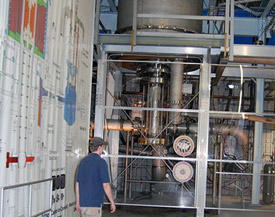
The lab's world-record 45 tesla hybrid magnet.
The premier magnet system at the Magnet Lab is the hybrid magnet, and this is a combination of two similar ways of making a magnetic field. We have the superconducting technology, or superconducting wire, that uses very little power, but has a limit on how high a magnetic field we can have. The limit is where the wire stops becoming a superconductor and in fact becomes a rather bad conductor. So to get to ever higher fields, we use resistive magnets, which use a large amount of electric power and cost us a lot of money to run. The best way to get to the ultimately high fields is a combination of the two, and this is the hybrid, the hybridization of the two technologies. We take the superconducting magnet on the outside, and on the inside, at the very high fields, we put a resistive magnet that consumes power. That way we can get to the highest fields with a minimum use of electric power. This gives us the 45 tesla hybrid, the highest steady magnetic field in the world. We've combined an 11.5 tesla superconducting magnet on the outside, and inside we have a 34 tesla magnet that gives us a total of the 45 tesla. One of the operational problems of a hybrid magnet is that you have to keep the superconducting magnet cold, in this case about 1.5 degrees Kelvin above absolute zero, while still running a huge power-generating magnet in the middle of it. The combination of these two is a very difficult engineering problem, both electrically and mechanically, to keep these two from damaging each other or causing large voltages or other problems.
Read more about the MagLab's magnets.


